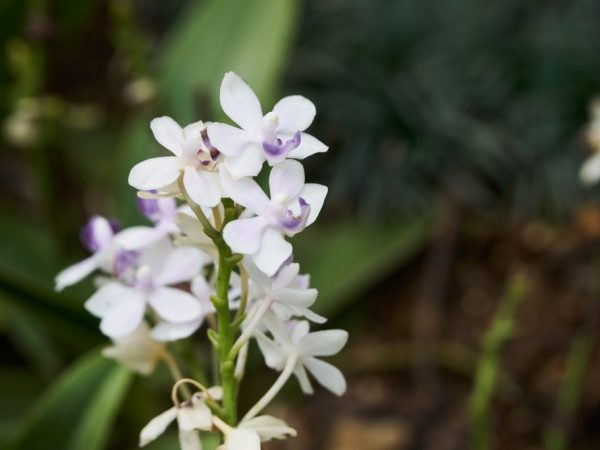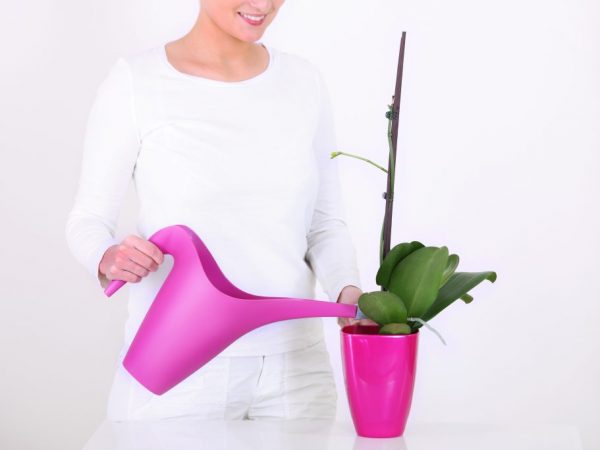Growing Phalaenopsis Sapphire
Phalaenopsis Sapphire is a popular culture. A distinctive feature of this variety is that it tolerates high air temperatures without harming the structure.

Phalaenopsis Sapphire
Plant characteristics
An adult plant grows up to 50 cm in height. It has a dense stem, green leaves with small white spots.
The buds consist of 10-20 small flowers of a blue or light blue hue. The diameter of the flower is 3 cm. 5-6 months after planting, the peduncle branches. The number of flowers increases every year. Phalaenopsis Sapphire blooms at intervals of 5-6 months. The duration of the flowering period is a month.
Recommendations for agricultural technology
Phalaenopsis Sapphire is propagated in several ways:
- children that grow in the soil from the main stem;
- sockets;
- shoots formed on the inflorescence.
For planting, choose natural soil. The ideal option is coniferous bark, which holds the plant well in the container. The pot must be transparent so that the root system receives the right amount of sunlight. A drainage system and high-quality ventilation are installed at the bottom of the pot. This allows the orchid to participate in photosynthesis.
The roots of the seedling are distributed around the entire perimeter of a transparent container and sprinkled tightly with the prepared substrate. Planting depth - 5-6 cm. The pot is placed in a dark place for 7-10 days, after which it is placed on a windowsill from the north or east side (in such parts of the house, the sun's rays are refracted, not straight). The first 2-3 months watering is carried out with an interval of 10 days.
Care rules
Phalaenopsis Sapphire needs the right temperature, humidity and air flow.
Daytime temperature - 20-26 ° С. At night - 15-17 ° С. Air humidity - 60-70%. An orchid requires constant fresh air, but it is important to protect it from drafts.
The substrate is watered as it dries. The optimal watering interval, which is carried out using warm, settled water, is 2-4 days. In winter, when the orchid begins to bloom, the interval is increased to 5-7 days.
Feeding Phalaenopsis Sapphire is carried out only during the period of plant preparation for flowering. With an interval of 10 days, the culture is watered with complex fertilizers (50 g per 5 l of water). The best option is Combi-Lux.

Sapphire Orchid Care
Transplant rules
The transplant is carried out when the root system has ceased to fit into the pot or the substrate has lost nutrients and began to decompose. The optimal transplant interval is 2-3 years. The inflorescences are cut off only after they are completely dry.
Pests and diseases
The main disease of the orchid is fusarium, root rot, anthracnose and leaf spot.
It is impossible to get rid of fusarium and root rot, so the plant is removed along with the roots.
It is possible to cure a culture of anthracnose with the help of Fundazol (30 g per 5 L of water). The plant is watered with a solution at intervals of 10 days. Topsin is considered an effective remedy against leaf spot.It is diluted in a ratio of 50 g per 10 liters of water, after which the orchid is watered with an interval of 7 days.
Worms and ticks are among the pests.
- They fight the worm by spraying the plant with a solution of laundry soap (1 bar is rubbed on a grater and diluted in 5 liters of water).
- The orchid is removed from the tick only by treatment with the preparation "Akarid" (20 g per 5 liters of water).
Prevention measures
In order not to face such diseases, they carry out prevention:
- The soil is treated with disinfectants before planting the seedling (manganese solution or oxychom).
- Follow the care recommendations. Most diseases are caused by improper care.
Conclusion
The Sapphire orchid variety needs quality care. If you follow all the recommendations, it will be easy to grow a plant resistant to pests and diseases.


